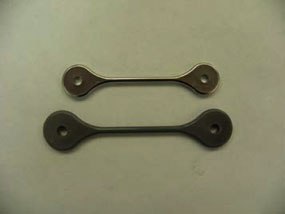Material Properties
Testing Standards
Industry standards for MIM have been formed by the regional trade associations such as the European Powder Metallurgy Association (Shrewsbury, UK) and Metal Powder Industries Federation (Princeton, NJ). The standards cover testing procedures for the powders and sintered materials, composition ranges for popular materials, and property levels for sintered materials.
With respect to mechanical properties, several test bar geometries are used in MIM. Flat tensile bars are easily formed by MIM using low cost tooling. After sintering, depending on the initial solids loading and sintering shrinkage, the thickness ranges from approximately 4 to 6 mm cross- section and 20 to 30 mm gauge length is common (about 0.25 inch thick and 1 inch gauge). It is often molded in a cluster with other test samples, such as a transverse rupture bar or impact bar or corrosion test coupon, also useful for hardness tests.
Another tensile test sample option is a round bar 38 to 90 mm (1.5 to 3.6 inch) long with a typical diameter between 4 to 5 mm (0.16 to 0.2 inch). A hybrid tensile bar design is flat but rounded, but it has a tendency to give premature fracture out of the gauge length.

Sintered test bar (top) Green test bar (bottom)
Impact bars range from square cross-sections 10 mm by 10 mm by 55 mm length (0.4 by 0.4 by 2.2 inch) to subsize samples of one-half or one-fourth the cross-sectional area. In some cases the samples lack the standard 2 mm deep 45° notch. So several variants are in use. Because of sensitivity to the test sample, users should decide if impact testing is needed and elect a geometry relevant to their application.
Other property tests are covered by standard industry tests, including magnetic properties. Here the convention is to use a 25 oersted maximum applied field. Other data might include surface finish, microstructure, grain size, porosity, hardness, wear resistance, corrosion resistance, chemical composition, and various other parameters.
Corrosion testing can be simple using immersion tests. One corrosion test applied to MIM stainless steels is to immerse a sample 5 by 10 by 55 mm (0.4 by 0.4 by 2.2 inch) in a 2% sulfuric acid solution at room temperature for 1,000 h. However, it is faster to rely on a 6 min immersion in a copper sulfate solution and to inspect for copper plating or other attack (ASTM F 1089). Other tests for corrosion include boiling water immersion for 30 to 180 min (ASTM F 1089). One effective test, commonly used but not standardized, is to immerse the sintered component in chlorine bleach and observe for discoloration over one minute.
